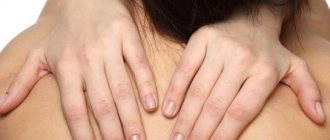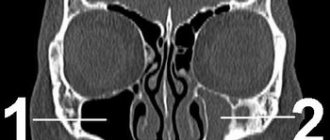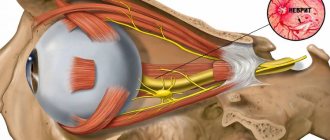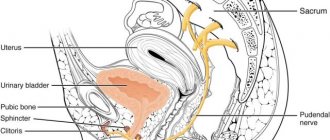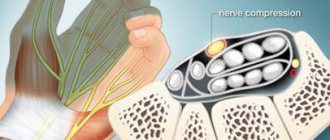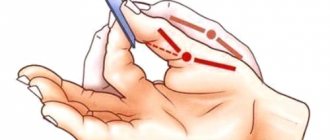September 24, 2019
66907
0
3.6 out of 5
The presence of occipital neuralgia is indicated when, as a result of irritation by certain factors of two large or two small occipital nerves, severe headaches occur. Attacks can reach such a frequency that they completely deprive a person of his ability to work.
But you can cope with the disease if you consult a neurosurgeon. The doctor will be able to accurately determine the causes of neuralgia and select the most appropriate treatment tactics in a particular case, including surgery. SL Clinic specialists have extensive experience and knowledge in the field of neurological disorders and are able, using modern treatment tactics, to significantly improve the patient’s quality of life or achieve complete elimination of signs of neuralgia. The price of a specialist consultation is available to everyone and is given in the price list.
Causes of a pinched nerve in the cervical spine
The rupture of connections and shock-absorbing abilities of the discs leads to pinched nerves in the cervical spine, the symptoms of which immediately appear due to:
- mechanical damage (displacement);
- inflammatory processes in tissues, edema;
- muscle pain;
- osteochondrosis and its consequences;
- heavy loads and lack of physical activity;
- excess weight.
A pinched nerve in the cervical spine, the symptoms of which manifest themselves in impaired motor activity, can be caused by hypothermia, hormonal imbalances, and metabolic problems.
Treatment of occipital neuralgia at SL Clinic
At SL Clinic you can receive qualified treatment for occipital neuralgia. Our vertebrologists will be able to thoroughly understand the causes of pain and purposefully influence them. This approach ensures maximum effectiveness of the therapy and increases the chances of a full recovery.
The cost of radiofrequency treatment of neuralgia of the greater occipital nerve is 68,000 rubles and depends on: - The cost of needles for radiofrequency ablation; — Clinics and class wards. The price includes: — Stay at the clinic before and after surgery; — Operation; — Cost of needles for radiofrequency ablation; — Observation and consultation during the rehabilitation period. All clinic services and costs are listed in the price list.
In most cases, conservative therapy, correctly constructed by our doctors, in combination with radiofrequency treatment, gives good results and eliminates the manifestations of neuralgia. Help from vertebrologists can be provided at the SL Clinic at the highest level. Modern operating rooms, the best equipment and highly qualified neurosurgeons who master advanced techniques are the key to the success of surgical treatment and its safety. All this can be provided to you by SL Clinic.
With us you can quickly complete all the necessary research at a time convenient for you. If necessary, our specialists will carry out a blockade or radiofrequency treatment to stop a severe attack and normalize the patient’s condition. Our prices make advanced European-level surgery affordable.
Don’t tolerate pain, sign up for a consultation at SL Clinic.
Symptoms
Radiculopathy does not always manifest itself with one sign; there may be several of them:
- Acute spasms in the cervical spine are characteristic symptoms of a pinched cervical nerve.
- Lack of sensitivity in hands.
- Weakness.
- Headache.
- Chest pain. Sometimes confused with a heart attack, but taking a vasodilator drug can help make the diagnosis clear. If after 60 minutes the spasms have not gone away, then these are symptoms of a pinched cervical nerve.
- Redness in the affected area.
Types of pain on the right
When a patient comes to the doctor and says that his neck hurts on the right side, at the first stage of diagnosis, a neurologist
trying to find out what exactly the nature of this pain is.
Sharp shooting pain
If pain in the right neck resembles a lumbago, most likely it is a pinched nerve ending. Since the neck is the most mobile segment of the spine, next to which there are many nerve endings, the resulting muscle spasm can cause pinching of any of these nerves. The result is a sharp “lumbago” in the neck on the right side. A muscle spasm in the neck and then a “lumbago” can occur due to injury, inflammation (of the lymph nodes, trachea, thyroid gland and other organs), or hypothermia.
Pressing dull pain
If the pain in the neck on the right is pressing and dull, then the most likely causes of its occurrence will be infections or inflammation in the cervical spine: osteochondrosis, osteoarthrosis, osteoporosis and other similar diseases. In addition, pressing dull pain can be a sign of heart failure, rheumatism, and various types of cancer. In other words, neck pain becomes an indirect symptom of diseases not directly related to the neck. Particular attention should be paid to pain in the neck on the right, which occurs in parallel with pain in the thoracic region. In this case, there is a possibility of a heart attack - you need to urgently call an ambulance.
Drawing/pulsating pain
The cause of throbbing or nagging pain in the neck on the right may be:
- injuries to ligaments, muscles, vertebrae;
- degenerative changes in the bone tissue of the spine (for example, osteoarthritis);
- osteomyelitis and other infectious diseases of bone tissue;
- oncology;
- referred cervicalgia.
Diagnostic methods
Detection of a pinched nerve in the cervical region begins with palpation of the affected area: if the nerve is compressed, then swelling appears and the mobility of the limbs and neck is limited. To determine an accurate diagnosis, the following procedures are often referred:
- x-ray
; - CT scan
; - electromyography;
- general blood analysis.
Diagnostics
Diagnosing occipital neuralgia is not difficult. This can usually be done at the first consultation with a neurosurgeon. Pain in the skin of the back of the head or numbness are clear specific symptoms of the disease. The doctor can finally confirm its presence by influencing special trigger points located along the greater or lesser occipital nerve on the affected side. This:
- Impact on a point located on a conventional line passing between the mastoid process and the occipital protuberance. If you divide it into 3 parts and press on the point located on the border of the upper and middle third, the patient will feel severe pain due to neuralgia of the greater occipital nerve.
- Pressure on the site at the junction of the sternocleidomastoid muscle with the mastoid process when the lesser occipital nerve is damaged causes an attack of pain.
But the main goal of diagnosis is to search for factors and diseases that caused its development. Otherwise, any treatment will be ineffective, and painful attacks will become more frequent, longer and more frequent. To detect the causes of the development of occipital neuralgia, a vertebrologist may prescribe to the patient:
- radiography;
- MRI;
- CT;
- UAC;
- blood chemistry;
- blood sugar test.
If during the studies no pathological abnormalities are found, neuralgia is recognized as primary, which determines further tactics for treating the disease.
First aid
The first step is to minimize pain. Ibuprofen and Diclofenac can be taken without a prescription from a specialist. They will relieve spasms in the vertebrae and minimize inflammatory processes in the area of the problem area. The patient should take a horizontal position. Before the specialist arrives, you should not take any action: massage your neck, do physical exercises. All this can be prescribed by a neurologist
after the examination.
Muscle pain
Spasms of the muscles of the neck and upper back occur due to injuries, physical strain during the day, in particular, incorrect postures, and emotional stress. Also, muscles can spasm due to an uncomfortable pillow. This condition usually manifests itself as pain and limited neck mobility. Within 6 weeks the pain goes away. To speed up the process, it is recommended to do special exercises, as well as eliminate the cause of muscle strain, if possible.
How to treat?
Be sure to apply compresses. If pressure on nerve endings causes muscle spasms, you can try muscle relaxants. However, it is better to use such medications under the supervision of a specialist. A pinched cervical nerve can be relieved in a variety of ways. A separate program is developed for each individual situation. At the initial stage, the use of a structure in the neck area will be prescribed. Treatment will also include physical therapy and spa treatments. A pinched cervical nerve can be eliminated using an integrated approach. Using various techniques at the same time guarantees relief from spasms. Taking painkillers alone will only give temporary results. The disease is dangerous because it leads to compression of the vessels supplying the brain.
Manual therapy
The doctor can select a set of measures to eliminate pinched nerves in the cervical spine, excluding the use of medications. Only those who are well versed in human anatomy should engage in therapy. Making the wrong decisions during therapy can cause disability for the patient. The most commonly prescribed types of manual therapy are:
- Relaxing massage. A few visits to a specialist will be enough to restore the functionality of the cervical spine. Acupuncture. Relieves cramps.
- Pharmacopuncture. Completing the course will relieve pain.
Ointments and creams
If spasms in the neck area do not go away for a long time, the doctor may prescribe the use of warming ointments and creams. The most popular product is propolis-based. But if the symptoms of the disease have just begun to appear, then the use of warming products will worsen the situation and lead to swelling in the neck area. If swelling appears, then from time to time you can apply cold to the problem area. If the use of prescribed medications does not help, the specialist prescribes corticosteroids.
Therapeutic gymnastics exercise therapy and massage
A course of massage is always prescribed, as it minimizes pain and restores metabolic processes and blood flow. When the pressure on the nerve is relieved, the spasms stop. It is best to combine massage with exercise therapy. The main goal of physical education is to strengthen the neck muscles. Programs are developed individually for each case. Complexes for the neck and lower back improve the condition of the spine, which allows you to properly distribute the load and free the nerve. It is better to do the exercises every day, regularly adding more approaches. Avoid performing the exercise during exacerbations.
Surgical intervention
In some cases, surgery is prescribed. But only when other methods do not have the desired effect. The operation is prescribed taking into account the patient’s age and health status. The recovery period after surgery lasts about three months. To consolidate the results of therapy, patients are recommended to wear chondroprotectors that renew tissue.
Treatment for neck pain
For each patient, treatment tactics are developed strictly individually based on the diagnosis, the severity of pathological changes, the presence of concomitant diseases and other factors. Even patients with the same disorders may be prescribed different treatments, since even age and level of physical development influence it.
Nevertheless, the treatment of diseases that cause neck pain is always complex and includes both symptomatic and etiotropic therapy. In other words, it is aimed at eliminating both the symptoms of the disease and the causes of its occurrence. The main components of therapy are often:
- drug treatment;
- osteopathy;
- manual therapy;
- massage;
- physiotherapy (phonophoresis, carboxytherapy, ozone therapy, RF current pressure therapy);
- individual sessions with a rehabilitation specialist.
When diagnosing pathologies of the cervical spine, it is recommended to make some adjustments to your lifestyle and habits. Thus, office workers, drivers, seamstresses and representatives of other sedentary professions are recommended to stretch as often as possible and avoid long-term forced body positions, especially ones that require tension in the neck muscles.
It is also important to eat properly so that the body receives all the substances it needs. This will not only slow down the progression of pathology, but will also contribute to faster regeneration processes.
In case of severe pain, the chiropractor may recommend that the patient purchase a neck brace or Chance collar. Wearing it will help relieve the load on the cervical spine and avoid making thoughtless sudden movements, which will lead to a gradual fading of the pain syndrome. In our center you can select and purchase a bandage that suits you
Before visiting a doctor, in order to reduce pain, you can wrap your neck with a woolen scarf or take a painkiller tablet no later than 12 hours before your appointment.
Drug therapy
The nature of the prescribed drugs and their quantity can vary within very wide limits, which directly depends on the diagnosis and the presence of concomitant diseases. Therefore, we list only those groups of drugs that are prescribed to the vast majority of patients:
- NSAIDs are nonsteroidal anti-inflammatory drugs that also have analgesic properties (produced in various dosage forms, including tablets, ointments, injection solutions, etc.);
- corticosteroids are drugs with a powerful anti-inflammatory effect, which are used only in cases of severe inflammatory processes that cannot be eliminated by NSAIDs;
- muscle relaxants - medications that eliminate muscle spasms of various origins, which helps reduce the severity of pain;
- chondroprotectors are drugs that promote the restoration of the cartilage tissue that makes up the intervertebral discs, but are effective only in the initial stages of the development of osteochondrosis. To prevent diseases of the musculoskeletal system, we recommend to our patients the most effective drug Mermaids Marine Collagen;
- B vitamins - are used to improve the conductivity of bioelectric impulses from the spinal cord to the corresponding organs and restore their proper functioning;
- Vitamin D is a remedy responsible for the condition of bone tissue, as well as for higher brain functions, such as memory, memory, attention, and speech.
Patients may also be prescribed antibiotics, hormone replacement therapy, antihypertensive drugs, and others.
For particularly severe pain in the neck, blockades are used. The procedures involve the injection of anesthetic solutions with corticosteroids into the area where the nerves pass in the neck, which allows for very quick pain relief. But, in addition to the fact that they are effective only for pain caused by nerve damage, they require a high level of professionalism from medical workers, since when performing a blockade there is a risk of injuring the nerve, causing infection and causing serious complications.
Manual therapy
Manual therapy is one of the most effective ways to combat neck pain and the causes of its occurrence, but only if carried out correctly. It involves a direct impact on the spine and surrounding soft tissues. Do not confuse manual therapy with therapeutic massage, which only works the muscles of the back and neck.
Techniques and methods of manual therapy allow literally after the first session to achieve a significant improvement in well-being, and ultimately complete remission. This is achieved through:
- restoration of the normal axis of the spine by returning the vertebrae to their anatomically correct position;
- increasing the distance between the vertebral bodies and releasing compressed nerves and blood vessels, which helps eliminate signs of radicular syndrome, improve the functioning of internal organs and especially the brain;
- elimination of spasm of neck muscles and functional blocks, which improves mobility and reduces pain;
- improving blood circulation and tissue nutrition.
We do not have general standards of treatment; we apply an individual approach to each patient. You should trust manual therapy only to a highly qualified specialist. Otherwise, the use of inappropriate techniques can only harm the patient, aggravate the problem, or provoke the development of complications.
Physiotherapy
Physiotherapeutic procedures are used to increase the effectiveness of the therapy. They are indicated exclusively outside the acute period and have an analgesic, anti-inflammatory effect, and also improve microcirculation in soft tissues and help normalize muscle tone.
Typically, courses consisting of 8-15 procedures are prescribed. It can be:
- electrophoresis;
- UHF;
- ultrasound therapy;
- laser therapy;
- traction therapy (spinal traction);
- mud baths, etc.
The number of sessions of physiotherapeutic procedures and the frequency of their implementation are selected by the doctor individually. Some procedures can be combined with each other, while others should be performed strictly at a certain interval.
Exercise therapy
Physical therapy is one of the mandatory components of conservative therapy for neck pain. Since very often they occur against the background of muscle overstrain and the resulting degenerative-dystrophic processes in the intervertebral discs, it is important to pay due attention to exercise therapy and practice daily.
For each patient, a physical therapy program is developed separately by a rehabilitation physician. Using complexes presented on the Internet can be dangerous, since they do not take into account the individual characteristics of the patient, his age, the degree of neglect of the pathological process and the level of physical fitness of the patient. Therefore, to develop a physical therapy program, the help of a specialist is required. Moreover, the first few classes must be carried out under his supervision, so that the patient can understand how to perform each exercise and does not harm himself in the process of independent training. You should exercise at home in a calm environment, avoiding any sudden movements, and if pain occurs, you should consult a doctor.
Thus, neck pain is a widespread phenomenon. They can be caused by the development of various diseases, but most often the cause of discomfort is problems with the spine caused by a sedentary lifestyle. Therefore, you should not hesitate to consult a doctor. Indeed, in the early stages of the development of the disease, it can be easily dealt with using conservative methods. While in advanced cases, neck pain and the causes that cause them can be eliminated exclusively through surgery.
5 1 vote
Article rating
Prevention
The best way to cure the disease is to take preventive measures. Timely prevention of pinched cervical nerve will save you from severe pain. Prevention consists of following the following recommendations:
- if your work activity involves constantly being in a sitting position, you will have to take breaks to do physical exercises;
- an orthopedic mattress and pillow will create the necessary conditions for sleep;
- keep your back straight;
- do not lift heavy objects;
- Swimming and yoga are ideal ways to prevent pinching in the cervical spine.
Features of therapy
The main question for patients is what to do if the neck hurts on the right side, how to treat such pain and how to get rid of its causes? There are several methods of therapy.
Medication
To treat neck pain, various medications are used that have analgesic and anti-inflammatory effects. These can be tablets or gels (ointments). To suppress severe pain syndromes, injections are used that have a chondrostimulating, blocking pain impulse transmission and anti-inflammatory effect.
Manual therapy, massage
Manual therapy and massage have a beneficial effect on the movement of blood in the vessels, on the condition of muscles and bone tissue. There are acupressure, reflex-segmental, hardware, etc. massages.
Gymnastic exercises
Special gymnastic exercises can be prescribed both as prevention and as part of treatment. As a rule, the complex includes simple exercises (turns, tilts of the head, and similar actions) aimed at developing muscles.
Traditional methods
Even with the active development of medicine, folk remedies for treating diseases continue to be popular among many patients. Why not if it really has an effect? Various compresses can be used as treatment - from cabbage leaves, vodka and honey, horseradish. Homemade ointments are also used, which may include coltsfoot, parsley, apple cider vinegar and other components. It is worth noting that self-medication, even using folk methods, is unacceptable. Any therapy must be coordinated with your doctor. For example, compresses cannot be used for inflammatory and infectious diseases, as they can only provoke an even greater development of the disease.
Where can the pain go?
Pain sensations can often be misleading. The patient often does not associate symptoms directly with the spine. The reason for this is the varied irradiation of pain during the disease.
You may experience pain and discomfort in the following parts of the body:
- Neck;
- Arm (from shoulder to fingertips);
- Scapula and collarbone;
- Back of the head;
- Heart area.
Heart pain often forces people to see a cardiologist. The differences between such pain and cardiac pathologies are visible on the cardiogram. In case of problems with the neck, there will be no deviations. This pain does not cause shortness of breath and is often unilateral. The sensations are quite long lasting, unlike ischemic pain.
Symptoms of cervical neuralgia
The main symptom of the pathology is headache. With occipital neuralgia, it has a specific character:
- pain is concentrated behind the ears, in the back of the head, lower neck, in the eye area;
- painful attacks occur suddenly, usually after turning the head or touching the area of innervation of the occipital nerve;
- pain is more often localized on one side, bilateral damage is less common;
- the pain has a shooting character, appears sharply and suddenly disappears;
- bright light causes pain in the eyes.
In addition to pain, symptoms of neuralgia of the head include:
- impaired sensitivity in the back of the head;
- forced head position;
- pale skin;
- feeling of "goosebumps";
- feeling cold;
- increased pain when coughing, sneezing, turning the head.
Diagnosis of inflammation of the occipital nerve
The clinical manifestations of the disease are similar to migraine and a number of other neurological pathologies. Help to identify the disease:
- radiography;
- CT scan;
- Magnetic resonance imaging.
